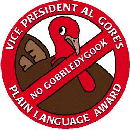Archive

Related Resources:
06/01/98: Memorandum on Plain English in Government Writing
Federal Communicators Network and Plain Language Action Network Workshop Internet Resources
OSHA's Marthe Kent Gets the First Plain Language Award
Vice President Gore Presents Second Plain Language Award
Vice President Gore Presents Third Plain Language Award to GSA Employees
Vice President Gore Presents Fourth Plain Language Award to HUD Employees
REMARKS BY VICE PRESIDENT AL GORE
AS PREPARED
PLAIN LANGUAGE-TURKEY AWARD
Tuesday, November 24, 1998
I am delighted to be here today, to present our fifth Plain Language Award
-- continuing our crusade to reinvent government by putting our
communications into everyday language that anyone can understand. And today
we're making an important web site simpler, so millions of Americans can
enjoy this Thanksgiving holiday with safety and peace of mind.
Later this afternoon, President Clinton will continue a tradition of holiday clemency that reaches all the way back to President Truman. He will conduct a Thanksgiving "turkey pardon" -- freeing a turkey that will then retire to a petting zoo in Virginia, where it can gobble away for the rest of its natural life.
And while this one turkey is pardonable, confusing language in government rules, regulations, and writings about food safety is not.
When it comes to all government communication, the principles of plain language are clear. Short is better than long. Active is better than passive. Everyday terms are better than technical terms. And clarity is better than gobbledygook.
This isn't just about good writing, it is about good government, and redeeming the promise of our democracy. Clear writing helps to create understanding and trust -- and trust is essential to people's faith in their own self-government. When it comes to something as critical as food safety, plain language is also a matter of good health. It can even save lives.
That is why the turkey you see posted beside me takes on a double meaning. Today's award is about making Thanksgiving safer, by getting rid of the gobbledygook in the cooking advice we provide to Americans. With Americans getting ready to consume 45 million turkeys this week, I'm sure you'll agree that this is serious business.
Until very recently, the USDA web site that provides information on safe turkey and stuffing preparation read as follows: "if stuffing a turkey, use a meat thermometer." Instantly, I wonder -- if I've been using a spoon, have I been doing something horribly wrong?
It then goes on to say: "Cooking a home-stuffed turkey can be somewhat riskier than cooking one not stuffed. Bacteria can survive in stuffing which has not reached the safe temperature of 165* F, possibly resulting in foodborne illness. Even if the turkey itself has reached the proper internal temperature of 180* F, in the innermost part of the thigh, the stuffing may not have reached a temperature in all parts of the stuffing sufficient to destroy foodborne bacteria. If stuffing does not reach 165* F when the turkey itself is done to 180* F, further cooking will be required... ... During the added cooking necessary to bring the stuffing up to a safe temperature, the meat may become overcooked."
By that point, I'm ready to say, "I'll pass on the stuffing, please" -- or at the very least, steel myself for some overcooked turkey. Only after two dense and dire paragraphs do we get to the real point -- that it's much safer and easier to simply cook the stuffing separately.
That's why the new, plainer web site begins at the beginning. It reads: "Here are the most important things to remember about stuffing. Cook the stuffing separately -- it's much safer! If you absolutely have to cook the stuffing in the turkey, use a thermometer to make sure the stuffing reaches a temperature of 165* F and the turkey reaches a temperature of 180* F in the innermost part of the thigh. Measure the temperature of both the turkey and the stuffing! Don't trust a pop-up indicator. "
Checking the temperature -- that's what the meat thermometer is for. Your federal government was never suggesting that you use a meat thermometer as a utensil.
We have Bessie Berry to thank for this new simplicity and clarity. Bessie is the Branch Chief of the Meat and Poultry Hotline at USDA, where they handle 130,000 phone calls a year -- mostly at Thanksgiving time, and often from panicked people asking about safe food handling. You may have read about her team in last Sunday's Washington Post. This is actually not the first time Bessie and I have met -- we met at our food safety event right before the Fourth of July. Bessie showed me how to follow safe barbeque procedures. Today, I am proud to return the favor, and present Bessie with this richly deserved "No Gobbledygook." award. [present award]
Thanksgiving is a time for family and friends -- a time to reflect on our many blessings, and enjoy one of the most traditional holiday feasts. Because of the principles of plain language -- and because of the dedication of Bessie Smith and her colleagues at USDA -- America's meals will be safer, because our language will be clearer. That's something for which we can all be thankful this holiday season.